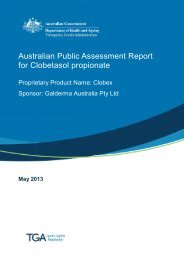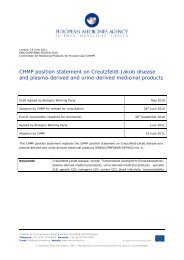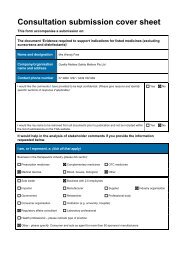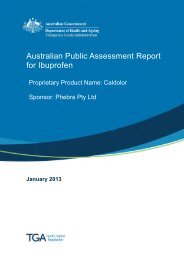AusPAR: Ivabradine - Therapeutic Goods Administration
AusPAR: Ivabradine - Therapeutic Goods Administration
AusPAR: Ivabradine - Therapeutic Goods Administration
Create successful ePaper yourself
Turn your PDF publications into a flip-book with our unique Google optimized e-Paper software.
Secondary endpoints in RSBBdose population<br />
All-cause<br />
mortality<br />
Cardiovascular<br />
death<br />
Hospitalisation<br />
for worsening<br />
heart failure<br />
NA= not available<br />
Only the subgroups of<br />
“females”, “ischaemic cause”,<br />
“NYHA Class II”, “no<br />
hypertension” and “baseline HR<br />
≥ 77 bpm”<br />
Only the subgroups of<br />
“females”, “ischaemic cause”,<br />
“NYHA Class II”, “no<br />
hypertension”, “baseline HR ≥<br />
77 bpm”, “age ≥ 65 years”, and<br />
“no DM”<br />
in all the pre-specified<br />
subgroups except the subgroup<br />
of “age ≥ 65 years”.<br />
Table 10. (iii) Analysis in subgroup of age ≥ 75 years<br />
Primary composite<br />
endpoint in RS population<br />
Cardiovascular death in RS<br />
population<br />
Hospitalisation for<br />
worsening heart failure in<br />
RS population<br />
NA= not available<br />
Conclusion and issues<br />
Relative Risk Reduction<br />
(in favour of <strong>Ivabradine</strong>)<br />
<strong>AusPAR</strong> Coralan <strong>Ivabradine</strong> Servier Laboratories (Australia) Pty Ltd PM-2010-03269-3-3<br />
Final 31 October 2012<br />
<strong>Therapeutic</strong> <strong>Goods</strong> <strong>Administration</strong><br />
All the interaction tests had pvalues<br />
higher than 0.05<br />
NA<br />
NA<br />
11% NA<br />
29% NA<br />
8% NA<br />
P value<br />
Analysis of heart rate changes confirmed the HR reducing effect of ivabradine, showing<br />
that with the mean doses of ivabradine 5.8 to 6.4mg b.d there was a mean change in HR of<br />
approximately -15 bpm at Day 28 and -12 bpm at last post randomisation visit. Similar<br />
reductions in HR were observed in the subgroup of patients who were on at least 50% of<br />
the target doses of recommended beta blockers (RSBBdose population) and in the subgroup<br />
of “age ≥ 75 years”, suggesting that the HR-reducing effect was exerted in these patient<br />
populations as well. However, the HR-reducing effect of ivabradine was expected based on<br />
its known pharmacodynamic properties. The efficacy results of this study would need to<br />
show whether this reduction in HR observed, which is mediated through a direct effect on<br />
the sino-atrial node independent of any inhibitory effect on the sympathetic system, can<br />
be translated to reduced morbidity or mortality in CHF patients.<br />
In the main analysis in the RS population, although there was a statistically significant<br />
relative risk reduction of 18% in favour of ivabradine for the primary composite endpoint<br />
the result was driven almost entirely by the component endpoint of hospitalisation for<br />
worsening heart failure. All 3 hospitalisation endpoints of all-cause hospitalisation,<br />
Page 32 of 101
















